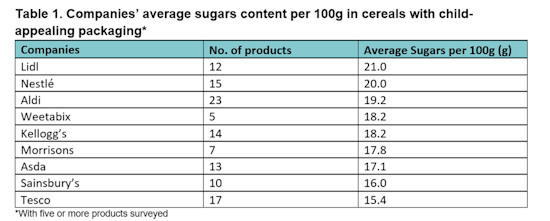Research for Action on Sugar, carried out by Queen Mary University of London, has revealed that both breakfast cereals and yogurts, with packaging that appeals to children, have “unnecessary” amounts of sugars, with some products containing the equivalent of up to four teaspoons of sugar per serving.
The campaign group noted that this is despite breakfast cereals and yogurts having celebrated the largest reductions in sugars between 2015 and 2020 (14.9% and 13.5% respectively) as part of the Government’s Sugar Reduction Programme – which is still shy of the 20% target they were supposed to achieve.
Given that only nine cereals and six yogurts surveyed were found to be low in sugars and only four cereals were low in both sugars and salt, the group is calling for the complete removal of packaging that appeals to children from these products that are high or medium for sugars, salt and/or saturated fat.
For the first time, Action on Sugar compared the average amount of sugars per 100g in each company’s range of products with packaging that would appeal to children (Table 1 and Table 2). The findings were as follows:
Cereals
47% of cereals surveyed contained one-third of a 4–6-year-olds daily maximum sugars recommendation (19g / 5 tsp) in one bowl (based on the manufacturer’s serving, excluding milk).

On average, Lidl, Nestlé and Aldi contained the highest sugars per 100g across their range of cereals with packaging that appeals to children.
Yogurts
65% of yogurts surveyed contained one-third of a 4–6-year-olds daily maximum sugars recommendation (19g / 5tsp) based on the manufacturer’s recommended serving.

On average, Nestlé, Lidl and Aldi contained the highest sugars per 100g across their range of yogurts with packaging that appeals to children.
Whilst there are restrictions in place to prevent the irresponsible advertising of foods high in fat, salt, and sugar during peak viewing times for children, Action on Sugar stated that a loophole exists when it comes to product packaging. Unlike advertisements, there are no specific restrictions governing the visual appeal and design of packaging which influences children’s preferences. The group suggested that a potential solution lies in redirecting such visually captivating packaging strategies towards healthier food products, which are sold in plain packaging targeted at adults.
Registered Nutritionist Dr Kawther Hashem, Campaign Lead at Action on Sugar based at Queen Mary University of London, commented: “It’s ludicrous that whilst breakfast cereals and yogurts celebrate the largest reductions in sugars during the Sugar Reduction Programme, those same products with child-appealing packaging still have excessive amounts of sugars, unsuitable for regular intake by children.
“Given the soaring numbers of under-18s suffering weight-related health problems and tooth decay being the leading cause of child hospitalisation, now is the time for companies to be forced to remove child-appealing packaging from products that are misleading parents and making our children unhealthy and sick.”
Zoe Davies, Nutritionist at Action on Sugar based at Queen Mary University of London, added: “There is no reason why products with high or medium levels of salt or sugar should be marketed as ‘suitable for children’. If we are to protect the health of our future generation, then bold action is required now from both government and companies alike, and this must include child-friendly packaging only being placed on healthier products.”



